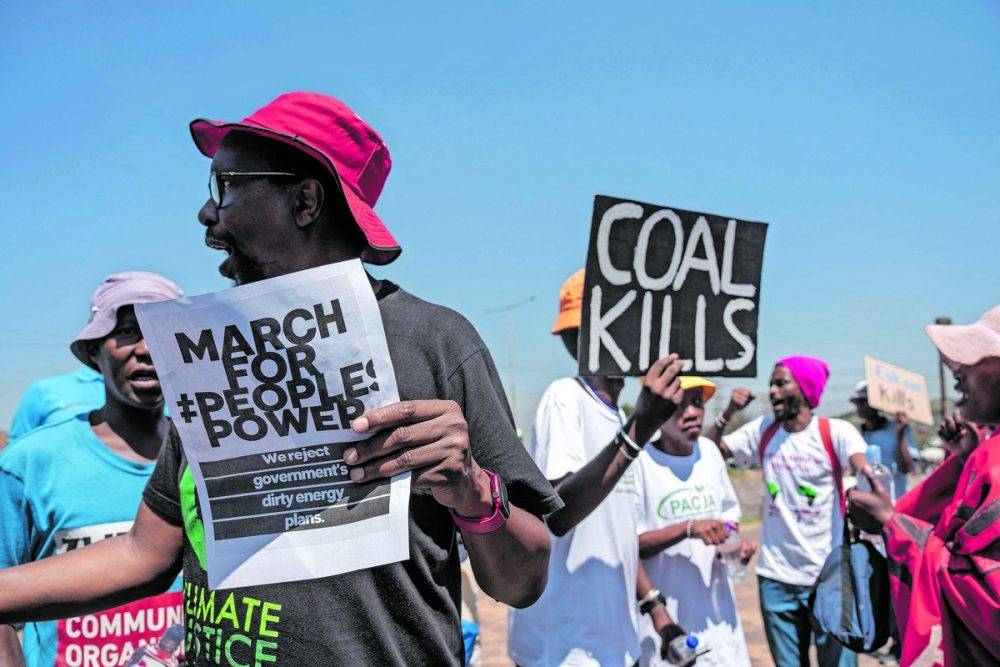
Enjoying soiled: Environmental activists in Soweto protest in regards to the air air pollution created by state-owned vitality firm Eskom’s coal-fired energy stations earlier this yr. Picture: Ihsaan Haffejee/Anadolu/Getty Pictures
At the UN local weather change convention COP29, which can happen later this yr in Azerbaijan, a key speaking level will probably be international locations’ progress in preserving the world at a 1.5°C temperature enhance.
Primarily based on a letter despatched out by the United Arab Emirates (UAE) COP 28 presidency, the Azerbaijani COP 29 presidency, and the Brazilian COP 30 presidency, ambitions to maintain the world at this degree will probably be one of many occasion’s essential discussions.
In keeping with the Paris Settlement, a authorized doc about preserving international local weather change beneath 2°C, international locations are known as on to decrease carbon emissions by forming nationally decided contributions (NDCs), that are commitments international locations make to scale back their greenhouse gasoline emissions as a part of mitigating local weather change. These commitments are set to be renewed subsequent yr as a part of the settlement.
COP29 appears to advertise discussions round what international locations want to realize international objectives of lowering local weather change. It should take a look at how international locations may be supported, what boundaries exist and the way implementing these NDCs may be achieved.
Assessing how far international locations are in reaching these objectives will probably be essential, particularly trying to subsequent yr, when they’re to be up to date.
Local weather Analytics, a world local weather science and coverage institute, has created a instrument to evaluate how international locations are faring with their NDCs forward of the essential COP29 this yr and COP30 subsequent yr in Brazil.
The instrument makes use of information from the Intergovernmental Panel on Local weather Change and scientific proof to point out how international locations throughout ranges of growth can align their decarbonisation efforts with the Paris Settlement to stop local weather change and its results.
Let’s check out how South Africa is progressing.
Underneath present insurance policies, the instrument says South Africa is not going to attain its local weather objectives. To achieve the objective of 1.5°C, emissions might want to fall considerably. It discovered that coal should be phased out by 2030 to 2035.
Coal makes up most of South Africa’s energy provide, roughly 85%, and that should drop considerably if 1.5°C is to be reached.
However the draft Built-in Sources Plan (IRP), the nation’s vitality blueprint, highlights the necessity to lengthen the lifetime of coal. This isn’t according to the nation’s NDC ambitions as coal-fired energy stations contribute considerably to the nation’s emissions.
Coal remains to be featured within the plan as essential to stabilising the nation’s energy provide, the place the issues are nicely documented.
The IRP Horizon One requires a delay in decommissioning coal stations, which is likely one of the the explanation why the nation will battle to achieve its local weather objectives.
Whereas it doesn’t name for brand spanking new coal-fired stations, which is sweet, delaying decommissioning will undoubtedly not see the nation in a beneficial gentle on the talks.
Renewable initiatives are missing. “South Africa’s 2023 draft vitality plan envisions an estimated 22% renewables within the energy system by 2030, down from 33% within the 2019 plan. That is nicely wanting the 75-93% required beneath a 1.5°C-compatible pathway.
“Whereas market indicators, akin to record-breaking imports of photo voltaic elements in 2023, point out {that a} extra fast deployment of renewables is underway, stronger targets are wanted to information coverage and drive ambition,” the instrument discovered.
Nevertheless, the nation is making some strides in preventing local weather change. The lately signed local weather change invoice is one in every of them. It appears to “be certain that South Africa’s transition to a low-carbon and climate-resilient economic system and society isn’t constrained by coverage contradictions”, the presidency stated.
Renewables must be scaled up and never down — it is a key flaw within the draft IRP. The nation wants bold renewable rollouts to make sure our local weather objectives are realised.
The instrument discovered a “fast uptake of renewables reaching 93% of era by 2030 and close to phase-out of coal by 2030” may assist the nation attain its objective of net-zero emissions.
In its present kind, the renewable output for the nation is at 4.5 gigawatts of recent wind and photo voltaic between now and 2030.
Power author Nick Hedley writes this, mixed with non-public sector-led tasks, would raise the share of renewables within the energy combine to 22% by the tip of the last decade. It’s nowhere close to sufficient to achieve the local weather objectives.
To make sure renewables are scaled up funding should be secured. These funds want to return from COP negotiations. It should guarantee grid capability, which suggests extra renewable tasks can come on-line and a decrease reliance on coal. Funds are additionally wanted for renewable vitality applied sciences.
Closing the funding hole and making certain international locations can obtain their NDCs will probably be a objective at COP29.